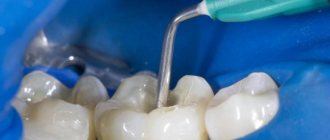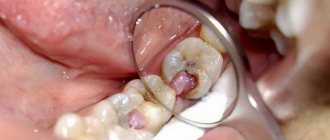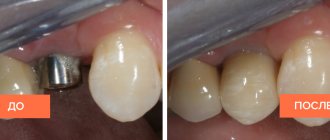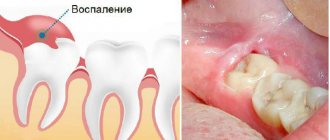Often dental treatment is not limited to just one visit to the doctor - in this case, at an intermediate stage, a temporary filling cannot be avoided. It is mainly used in the following cases:
- Treatment of acute deep caries. The border between dental tissues and the pulp chamber is so thin that the carious process can develop into pulpitis, and then root canal treatment will be required. Therefore, at the first visit, the dentist places a medicinal lining in the tooth and closes the cavity with a temporary filling. If the tooth continues to hurt under it, this indicates the need to change tactics.
- Treatment of pulpitis. In most cases, pulp inflammation is treated in two visits. First, it is necessary to necrotize the vessels and nerves so that later removal of the affected tissue and treatment of the canals will not be painful. To do this, during the first visit, a temporary filling with arsenic is placed.
- Treatment of periodontitis. Depending on the stage of the disease, medicine is placed into the root canals to stop the inflammatory process or to restore bone tissue (when a cyst is removed). In both cases, a temporary filling is needed. At each appointment, the dentist checks the condition of the root canals, as well as the tissues adjacent to it, and decides whether it is possible to permanently fill the tooth or whether it is worth putting a new portion of the drug.
- Preparation for prosthetics. In some situations, a temporary filling is placed on already cured and filled canals - for example, before installing a pin or orthopedic structure.
Composition of temporary filling
The main difference between temporary fillings and permanent fillings is their composition. They are usually made from the following materials:
- Artificial dentin. This is a mixture of zinc oxide and sulfate powders with distilled water.
- Vinoxol. It is a mixture of zinc oxide powder and liquid. It has good adhesion and antiseptic properties, and due to its high strength, a temporary filling made from this material can last up to six months.
- Dentine paste. White homogeneous mass with essential oils. The material is plastic, has excellent adhesion, and has water-repellent properties.
- Zinc-eugenol cement. It contains zinc oxide and clove oil or the fragrant substance eugenol. A temporary filling made from this material has good adhesion, an analgesic effect, antiseptic properties, and resistance to increased loads.
- Polycarboxylate cement. It is a mixture of zinc oxide powders, copper and liquid. It has good ductility, resistance to moisture, and excellent adhesion.
- Karyosan - zinc oxide with eugenol.
All materials have their own hardening time and the period after which food can be eaten. For each case, the dentist himself determines the type and composition for filling the cavity, which will affect the price of the temporary filling.
Indications and contraindications for the use of arsenic
Arsenic acid is used for devitalization, that is, killing the dental pulp in order to then partially or completely remove it. Before the development of anesthesia, this was the only way in which it was possible to remove a tooth relatively painlessly, cure pulpitis and some other dental diseases.
Now the pulp is removed under local anesthesia and using drugs without arsenic. But there are indications according to which he is still placed. These include:
- Acute diffuse or chronic fibrous pulpitis;
- Chronic hypertrophic pulpitis in teeth with impassable and curved canals;
- Allergy to local anesthetics;
- Severe general condition, for example, after a heart attack or stroke;
- Inability to open the mouth wide due to contraction of the lower jaw.
Dentists emphasize that arsenic is not an alternative to pulp removal with anesthesia. The toxin is used as a last resort when the patient has indications for it.
Arsenic should not be placed in the dental cavity if:
- Allergies to paste components;
- Pregnancy and lactation;
- Increased eye pressure;
- Diseases of the urinary system;
- Unformed roots.
In pediatric dentistry, arsenic should not be administered to children under 1.5 years of age. But today, paste with arsenic acid is practically not used to treat pulpitis in a child. Pulp devitalization is carried out with other drugs.
How much does a temporary filling with arsenic cost?
The period for which a temporary filling with arsenic can be left in a tooth depends on various circumstances - the age of the patient, the condition of his teeth, as well as the means used by the dentist to kill the pulp. When setting the time frame, the option of placing the drug is also taken into account - on an unopened pulp chamber or directly on the exposed pulp.
Typically, a temporary filling with arsenic remains in the tooth for a day, but when treating multi-channel chewing teeth, this period can be increased to two days. When treating baby teeth with formed roots, this time is reduced to 18 and 24 hours, respectively. And if the latest generation of arsenic preparations are used, they can be left in the tooth for up to five days.
If you have been given a temporary filling with arsenic, you must strictly adhere to the deadlines and come to replace it at the time specified by the doctor. Prolonged residence of the drug in the tooth leads to the penetration of arsenic into neighboring tissues and its accumulation there, which can ultimately provoke periodontal inflammation.
Arsenic in the tooth
In most cases, toothache comes suddenly and a person is forced to put aside all his affairs and visit the dentist. Some people always associate dental treatment with pain and they think with fear about the upcoming visit to the doctor and try to postpone it indefinitely. But you cannot delay visiting the dentist, as the disease will develop further, and this entails the risk of complications.
In the process of dental treatment, specialists at the Costamed dental clinic use fast, painless and well-proven methods. But there are cases when the only possible option for removing the nerve is the use of arsenic.
Why do they put arsenic in the tooth?
Arsenic is administered in order to get rid of the dental nerve, which in turn causes pain in a number of dental diseases. The drug has a necrotic effect on the nerve, pulp and nerve endings through a direct cytotoxic effect on cells. It causes disruption of cell respiration, denaturation of pulp proteins, stops its blood supply, blocks the transmission of impulses that come from nerve endings, and leads to cell death.
Indications for using arsenic in teeth:
- Allergic reaction to anesthetic.
- Limited time.
- Treatment by the doctor on duty due to urgent indications.
- The body's immunity to the effects of anesthetics.
- Inability to administer anesthesia due to the patient's health.
- Dental treatment in children when it is impossible to use local anesthesia.
How dangerous is the use of arsenic?
The product used in Perm dentistry is not pure arsenic, but its derivative. It is placed deep into the tooth, and the specialist will put a filling on top, so the paste will not get into the stomach or blood. Even if a patient’s filling accidentally falls out and he swallows it, this will also not cause harm to his body, since the proportion of arsenic contained in the paste is minimal.
Consequences of untimely removal of arsenic from a tooth
Arsenic is a poison. Even though its concentration in the paste is low, if it is not removed in a timely manner, it can cause an inflammatory process in the tooth tissues. The consequences can be very negative; the patient may develop diseases such as periodontitis or periostitis.
Please note that a temporary filling may fall out on its own or last for about 6 months or even a year.
Some patients are confident that if they do not feel pain, they may not visit the dentist again, and continue to walk with arsenic in their teeth. This should absolutely not be done, since with prolonged contact with tissues, the paste will gradually poison the entire body. Doctors apply the paste for a certain period of time; during this period it cannot cause significant harm. The next visit is scheduled to remove the paste from the tooth and place a permanent filling.
Contact the Costamed clinic with any problems related to health and oral diseases. You can make an appointment with a dentist using the online appointment form or call. Registration is made 24 hours a day. Call now!.
What kind of substance?
How long you can keep arsenic in a tooth depends on the disease, because the substance has a strong analgesic effect, completely killing the nerve. Today, such a remedy is considered obsolete, but it has still not lost its popularity in dental clinics.
Arsenic is a highly toxic and brittle non-metal. Its Latin name sounds like Arsenicum, and the remedy received its domestic nickname due to its popularity in baiting rodents. This drug can completely disrupt the metabolism of important microelements in humans if the dose is exceeded. The correct amount is calculated depending on weight and personal sensitivity to the active substance. That is why the question “How long can you keep arsenic in your tooth?” Only a specialist can answer for sure. Dangerous doses of this drug are measured in the range of only 5-50 grams.
When should you see a doctor?
As soon as the period of wearing the temporary filling, determined by the doctor, has ended, you need to see a dentist (see also: how many hours can you eat after installing the temporary filling?). He will remove the material, clean the canals and seal them. You also need to make an appointment with a doctor if:
- If a temporary filling falls out. The doctor will determine why this happened, apply another temporary composition or replace it with a permanent one.
- If the pain occurs even at night.
- If the pain is acute.
- When soft tissues are swollen or a severe allergic reaction occurs.
- With high temperature and fever.
Any complication after applying arsenic is beyond the norm, so it is better not to endure it, but to immediately consult a doctor. He will assess the condition and, if necessary, be able to prevent the development of pathology. Remember that arsenic is a poison, so you need to be careful when using it.
Pain after applying the product
For how many days is arsenic administered during dental treatment? For each person, this issue should be considered individually, but in any case, the substance should relieve painful sensations almost immediately after installation. The rapid anesthetic effect of the pastes is ensured by lidocaine, novocaine or dicaine included in the composition. If, even after a visit to the dentist, the pain does not subside, and sometimes manifests itself with even greater force, then, most likely, the doctor put an insufficient amount of the drug into the tooth or did it on a closed pulp, which provokes severe pain and swelling.
Of course, in addition to the possibility of medical errors, pain can occur for other reasons, for example:
- with an increased individual sensitivity threshold;
- slow effect of the drug;
- drug-induced inflammation;
- individual intolerance to any of the components of the paste.
The latter is fraught with serious consequences, so if swelling begins to increase along with pain, it is necessary to urgently call an ambulance. Drug-induced inflammation is also accompanied by swelling and increased body temperature. It provokes an abscess on the gum. The painful area should be immediately examined by a specialist.
Pain may not occur immediately after laying. Most often, they indicate the beginning of the death of the jaw bones, so the drug must be immediately removed from the tooth cavity. In any case, you shouldn't endure the pain. It is better to immediately contact a specialist for help.
Why is arsenic used?
Arsenic is a substance that is used in many areas at the same time. Metal production, semiconductor synthesis, painting, pyrotechnics, military affairs, household needs, medicine - this is an incomplete list of areas where this element is in demand. Doctors began to use it at the beginning of the 20th century to treat syphilis and anemia; Today, arsenic is widely used in dentistry.
A paste based on arsenic anhydride is placed on the tooth in order to kill the nerve. This need arises when the inflammatory process has already moved from the crown of the tooth to the pulp, and pulpitis has begun. Arsenic is also used in dental treatment when:
- the pulp bleeds heavily, which may be associated with severe inflammation, high blood pressure or the onset of the menstrual cycle in women;
- the patient is allergic to anesthetics;
- there is no time for long-term pain relief;
- local anesthesia does not work, most often against the background of severe anxiety.
If it is necessary to kill a nerve, the doctor will put arsenic, a temporary filling and send the patient home - the necrotic process will take several days (we recommend reading: how to kill a nerve in a tooth yourself and is this possible?). During the appointment, the specialist must warn about all precautions and possible side effects.
How long does a tooth hurt after arsenic administration?
To start the necrotic process in the tooth, dentists use arsenic in the form of a special paste; it also contains antiseptics, an anesthetic and a filler that helps give the paste its shape.
Read also: Gift sets for hookah
Why does the tooth sometimes start to hurt again? There are several reasons for this:
Usually the pain is aching in nature or appears with pressure. Tissue necrosis takes 2-3 days, and all this time the tooth may continue to hurt. If severe swelling occurs, consult a doctor.











